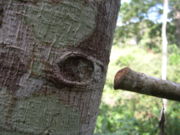
Cladoptosis
Encyclopedia

Botany
Botany, plant science, or plant biology is a branch of biology that involves the scientific study of plant life. Traditionally, botany also included the study of fungi, algae and viruses...
of the regular shedding of branches. It is the counterpart for branches of the familiar process of regular leaf shedding by deciduous trees. As in leaf shedding, an abscission layer forms and the branch is shed cleanly.
Functions of cladoptosis
Cladoptosis is thought to have three possible functions, self-pruning (i.e. programmed plant senescencePlant senescence
Plant senescence is the study of aging in plants. It is a heavily studied subject just as it is in the other kingdoms of life. Plants, just like other forms of organisms, seem to have both unintended and programmed aging...
), drought response (characteristic of xerophyte
Xerophyte
A xerophyte or xerophytic organism is a plant which has adapted to survive in an environment that lacks water, such as a desert. Xerophytic plants may have adapted shapes and forms or internal functions that reduce their water loss or store water during long periods of dryness...
s) and liana
Liana
A liana is any of various long-stemmed, woody vines that are rooted in the soil at ground level and use trees, as well as other means of vertical support, to climb up to the canopy to get access to well-lit areas of the forest. Lianas are especially characteristic of tropical moist deciduous...
defence. Self-pruning refers to the shedding of branches that are shaded or diseased and so potentially a drain on the resources of the tree. Drought response is similar to the leaf-fall response of drought-deciduous trees; however, leafy shoots are shed in place of leaves. Western red cedar (Thuja plicata
Thuja plicata
Thuja plicata, commonly called Western or pacific red cedar, giant or western arborvitae, giant cedar, or shinglewood, is a species of Thuja, an evergreen coniferous tree in the cypress family Cupressaceae native to western North America...
) provides an example, as do other members of the family Cupressaceae
Cupressaceae
The Cupressaceae or cypress family is a conifer family with worldwide distribution. The family includes 27 to 30 genera , which include the junipers and redwoods, with about 130-140 species in total. They are monoecious, subdioecious or dioecious trees and shrubs from 1-116 m tall...
. In tropical forests infestation of tree canopies by woody climbers or liana
Liana
A liana is any of various long-stemmed, woody vines that are rooted in the soil at ground level and use trees, as well as other means of vertical support, to climb up to the canopy to get access to well-lit areas of the forest. Lianas are especially characteristic of tropical moist deciduous...
s can be a serious problem. Cladoptosis, to give a clean bole with no support for climbing plants, may be an adaptation against lianas, as in the case of Castilla
Castilla (plant)
Castilla is a tree genus belonging to the family Moraceae found native in Central America. It is named after Juan Diego del Castillo Castilla (sometimes incorrectly spelled Castilloa) is a tree genus belonging to the family Moraceae found native in Central America. It is named after Juan Diego...
.

